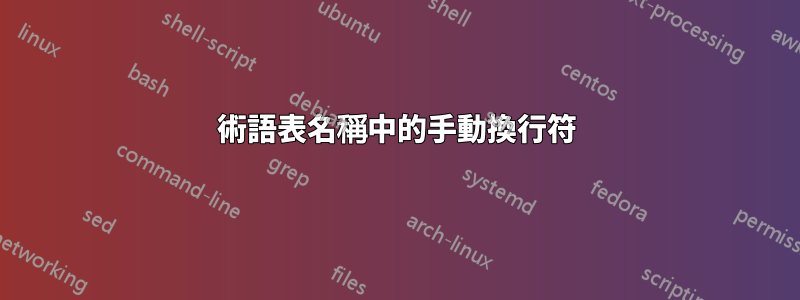
我在這裡找到了一種定義我自己的術語表風格的方法:
\newglossarystyle{superglossarystyle}
{
\setglossarystyle{super}
\renewenvironment{theglossary}
{
\tablehead{}
\tabletail{}
\begin{supertabular}{rp{\glsdescwidth}}
}
{
\end{supertabular}
}
}
%
\setglossarystyle{superglossarystyle}
如何在name- 字段中手動換行\newglossaryentry?
現在看起來如何:
ParameterA,ParameterB This is the description of ParameterA and ParameterB,
that is long and automatically wraps.
ParameterC This is the description of ParameterC, that is long
and automatically wraps.
它應該是什麼樣子:
ParameterA,
ParameterB This is the description of ParameterA and ParameterB,
that is long and automatically wraps.
ParameterC This is the description of ParameterC, that is long
and automatically wraps.
我嘗試添加\\,\linebreak,\tabbreak等作為換行符,但沒有成功。
\documentclass[pdftex,a4paper,oneside,12pt,halfparskip]{scrbook}
\usepackage[]{amsmath,amssymb}
\usepackage[ngerman]{babel}
\usepackage[T1]{fontenc}
\usepackage[utf8]{inputenc}
\usepackage[a4paper,top=3.6cm,bottom=3.6cm,left=3.6cm,right=3.6cm]{geometry}
\usepackage[]{glossaries}
\newglossarystyle{superglossarystyle}
{
\setglossarystyle{super}
\renewenvironment{theglossary}
{
\tablehead{}
\tabletail{}
\begin{supertabular}{cp{\glsdescwidth}}
}
{
\end{supertabular}
}
}
\setglossarystyle{superglossarystyle}
\makeglossaries
\newglossaryentry{pab}
{
name = {$\boldsymbol{ParameterA},\boldsymbol{ParameterB}$} ,
description = {This is the description of ParameterA and ParameterB, that is long and automatically wraps} ,
}
\newglossaryentry{pc}
{
name = {$\boldsymbol{ParameterC}$} ,
description = {This is the description of ParameterC, that is long and automatically wraps.} ,
}
\begin{document}
\glsaddallunused\printglossaries
\end{document}
答案1
標準列說明符是l, r,c是p{長度}。您可以使用以下命令定義新的列類型array包,但我認為在這種情況下不需要這樣做,因為您可以使用 調整段落對齊方式\raggedleft。在定義新的術語表樣式時,考慮該樣式的簡化版本會有所幫助。在基本層面上,樣式需要採用以下形式:
\documentclass{article}
\begin{document}
\begin{tabular}{p{2cm}p{4cm}}
\raggedleft A. & some text\\
\raggedleft AA. & some more text\\
\raggedleft AAA. & some more text
\end{tabular}
\end{document}
它有一個右對齊的段落樣式第一列。

現在測試如果ParameterA,ParameterB添加會發生什麼:
\documentclass{article}
\begin{document}
\begin{tabular}{p{2cm}p{4cm}}
\raggedleft A. & some text\\
\raggedleft AA. & some more text\\
\raggedleft AAA. & some more text\\
\raggedleft ParameterA,ParameterB & some text
\end{tabular}
\end{document}
這沒有換行,因為 TeX 無法插入換行符,所以結果相當難看。

相反,您需要為 TeX 提供一些範圍來在逗號處換行:
\documentclass{article}
\newcommand{\comma}{,\penalty \exhyphenpenalty}
\begin{document}
\begin{tabular}{p{2cm}p{4cm}}
\raggedleft A. & some text\\
\raggedleft AA. & some more text\\
\raggedleft ParameterA\comma ParameterB & some text
\end{tabular}
\end{document}
TeX 現在可以打破這條線:

2cm在這裡,我使用和硬編碼了列寬4cm,但glossaries套件定義了名為 的第二列的長度\glsdescwidth。您可以定義用於第一列的另一個長度:
\newlength\glsnamewidth
您需要根據您的文件設定該值。例如:
\setlength{\glsnamewidth}{3cm}
或者
\setlength{\glsnamewidth}{0.3\hsize}
新的術語表樣式可以定義為:
\newglossarystyle{superglossarystyle}
{%
\setglossarystyle{super}%
\renewenvironment{theglossary}%
{%
\tablehead{}%
\tabletail{}%
\begin{supertabular}{p{\glsnamewidth}p{\glsdescwidth}}%
}%
{%
\end{supertabular}%
}%
\renewcommand{\glossentry}[2]{%
\raggedleft
\glsentryitem{##1}\glstarget{##1}{\glossentryname{##1}} &
\glossentrydesc{##1}\glspostdescription\space ##2\tabularnewline
}%
}
完整的例子是:
\documentclass[pdftex,a4paper,oneside,12pt,halfparskip]{scrbook}
\usepackage[]{amsmath,amssymb}
\usepackage[ngerman]{babel}
\usepackage[T1]{fontenc}
\usepackage[utf8]{inputenc}
\usepackage[a4paper,top=3.6cm,bottom=3.6cm,left=3.6cm,right=3.6cm]{geometry}
\usepackage[]{glossaries}
\newcommand{\comma}{,\penalty \exhyphenpenalty}
\newlength\glsnamewidth
\setlength{\glsnamewidth}{0.3\hsize}
\newglossarystyle{superglossarystyle}
{%
\setglossarystyle{super}%
\renewenvironment{theglossary}%
{%
\tablehead{}%
\tabletail{}%
\begin{supertabular}{p{\glsnamewidth}p{\glsdescwidth}}%
}%
{%
\end{supertabular}%
}%
\renewcommand{\glossentry}[2]{%
\raggedleft
\glsentryitem{##1}\glstarget{##1}{\glossentryname{##1}} &
\glossentrydesc{##1}\glspostdescription\space ##2\tabularnewline
}%
}
\setglossarystyle{superglossarystyle}
\makeglossaries
\newglossaryentry{pab}
{
name =
{$\boldsymbol{ParameterA}\comma\boldsymbol{ParameterB}$} ,
description = {This is the description of ParameterA and
ParameterB, that is long and automatically wraps} ,
}
\newglossaryentry{pc}
{
name = {$\boldsymbol{ParameterC}$} ,
description = {This is the description of ParameterC, that is
long and automatically wraps.} ,
}
\begin{document}
\glsaddallunused\printglossaries
\end{document}
其產生:



